Tesla's Decade in China: The Halo Fades, and It's Time to 'Pay Tuition'
![]() 03/30 2025
03/30 2025
![]() 556
556
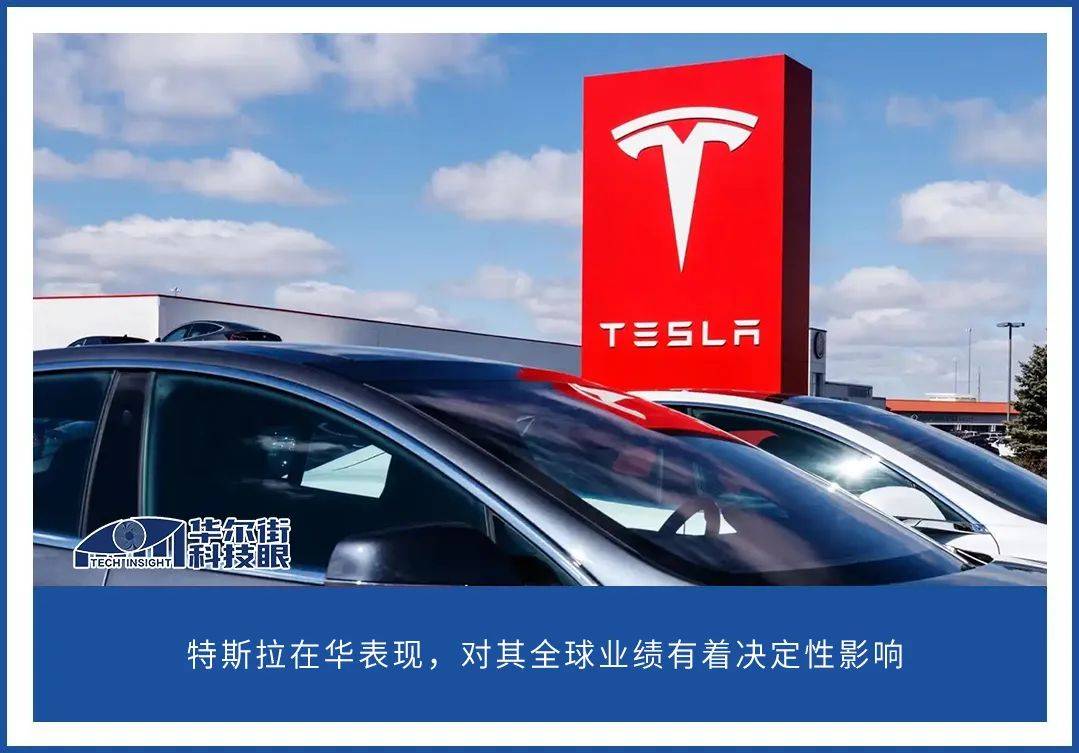
Written by/Du Jie
Edited by/cc Sun Congying
On March 11, U.S. President Trump made a bold statement by driving his self-funded $80,000 Tesla Model S into the White House. This move was no casual gesture but a deliberate show of support, with Trump openly hoping it would bolster Tesla's growth.
As a pioneer in the global electric vehicle industry, Tesla once heralded a new era with its innovative ideas and cutting-edge technology. However, the industry trailblazer now finds itself in deep trouble, facing unprecedented challenges. Even "Iron Man" Musk himself admitted in an interview that it was "very difficult" and that Tesla indeed needed a helping hand from the U.S. President.
The moment Musk stepped into the White House, Tesla's fortunes seemed to take a subtle turn for the worse. The company's share price is now in freefall, experiencing shocking declines, while sales continue to show a downward trend. In key markets like Europe and the U.S., Tesla is not only grappling with boycotts but also struggling to keep up with the pace of new model launches, gradually losing its competitive edge and finding itself in an unprecedented predicament.
Double Whammy! Tesla's Share Price and Sales are 'Falling Incessantly'
On March 10, Tesla's share price plummeted by over 15%, marking its biggest one-day drop since September 2020 and a decline of over 50% from its all-time high on December 17, 2023. This was the seventh-largest single-day decline since Tesla's listing.
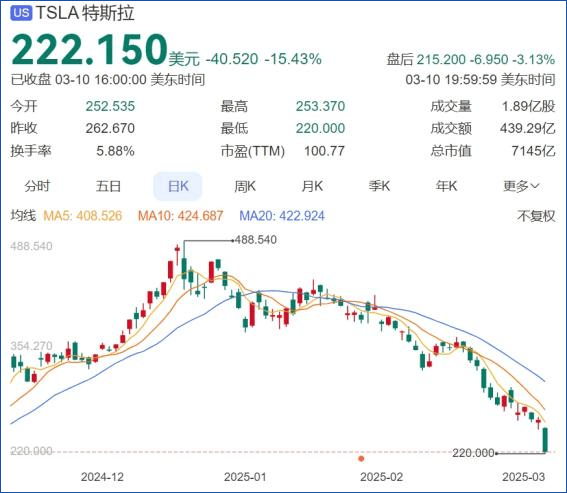
Tesla's share price fell by more than 15% on March 10.
The sharp decline in Tesla's share price is the result of multiple factors converging. Since Musk assumed the role of head of the U.S. government's Department of Efficiency (DOGE), a series of diplomatic controversies have erupted, with his controversial remarks and actions frequently sparking heated public debate. This has led to a wave of boycotts against Tesla in many parts of Europe and the U.S., with some Tesla showrooms in the U.S. even facing violent attacks, significantly damaging Tesla's market image and business operations.
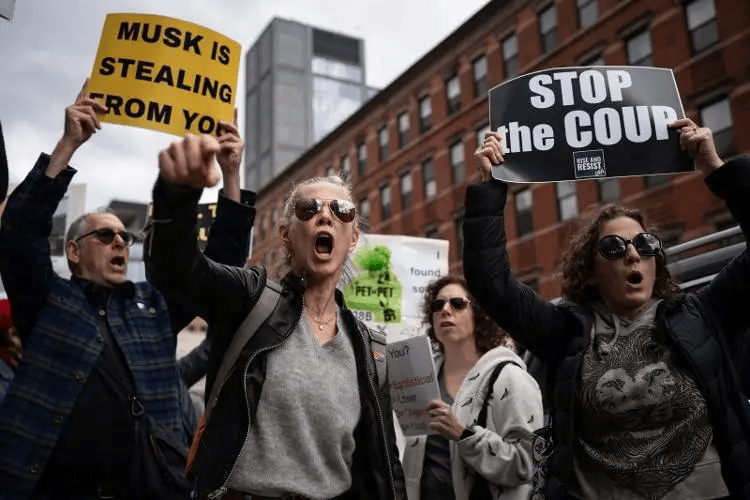
Figure: Due to Musk's outrageous remarks and actions, there have been continuous protests against Tesla recently.
Compared to other adverse factors, the decline in sales is undoubtedly a more critical blow to Tesla. In 2024, Tesla narrowly missed its global sales target, marking the first sales decline in a decade and casting a shadow over the company's future.
This crisis has continued into 2025, with the European market bearing the brunt. Data from the French Automobile Association shows that from January to February this year, new Tesla registrations fell by 45% year-on-year. In the German market, new Tesla registrations last month plummeted by 76%. In Norway, Tesla's market share dropped from 18.9% last year to 8.8%. The situation in Sweden and Denmark is equally dire, with new Tesla registrations falling by 42% and 48%, respectively.
The U.S. market has also not been spared. According to research firm MarkLines, Tesla's new car sales in February decreased by 5% year-on-year, marking the fourth consecutive month of decline. Goldman Sachs predicts that Tesla's first-quarter deliveries will be approximately 375,000 units, lower than the previous estimate of 399,000 units, with future performance remaining highly uncertain.
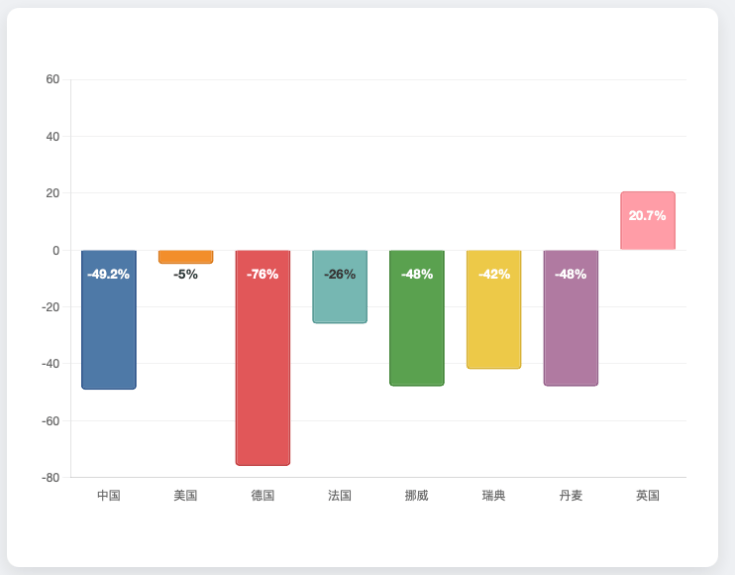
Figure: Tesla's sales growth and decline in February in some countries.
Tesla's Dilemma in China: New Challenges for an Old Giant
The Chinese market is strategically crucial for Tesla, being the second-largest globally after the U.S. Tesla's performance in China significantly impacts its global performance. However, in recent years, Tesla's situation in China has become increasingly complex, with declining sales being just the tip of the iceberg.
Data from the China Passenger Car Association clearly shows that Tesla's sales in China fell by 49.2% year-on-year in February, reaching only 31,000 units, the lowest since August 2022. In the first two months, Tesla's cumulative sales were 94,000 units, a decline of 28.7% compared to the same period last year.
Chinese consumers' sentiment towards Tesla is extremely complex. Tesla was the first new energy vehicle brand many Chinese encountered, quickly capturing the market with its unique technological concept and pioneering image. However, with the rapid rise of domestic new energy forces such as BYD, NIO, Xpeng, and Li Auto, consumers now have more diverse choices, and Tesla's market advantage has been continuously weakened.
Tesla's main sales models in China, the Model 3 and Model Y, were launched in July 2017 and March 2020, respectively. Although subsequent updates have been made, most have been minor adjustments. Long-standing issues complained about by car owners, such as cramped interior space, overly simplistic interiors, and stiff chassis tuning, have not been effectively resolved. Moreover, its control design has become increasingly aggressive, deviating from the needs of some consumers.
In terms of product layout, Tesla is also in a passive position. The highly anticipated entry-level model, Model Q, has yet to make its debut, and the Cybertruck, announced five years ago, has not yet entered the Chinese market due to various factors. The high-end Model S and Model X not only still need to be ordered through overseas imports but also have a very slow speed of updates and iterations, making it difficult to meet the growing demand for high-end models among Chinese consumers.
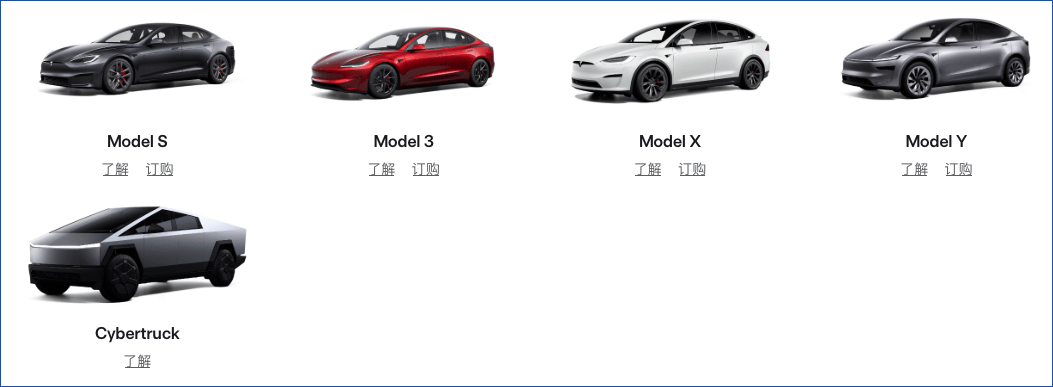
Figure: On Tesla's China official website, the Cybertruck cannot be ordered yet.
Tesla's pride and joy, the intelligent assisted driving feature FSD, is also facing challenges in the Chinese market. Due to limitations in data acquisition, computing power support, and regulations and policies, the FSD version adapted to the Chinese market lacks sufficient training for complex local road scenarios. Even if car owners pay a usage fee of up to 64,000 yuan, they still face the risk of violating traffic regulations during use, far from the technological experience promoted by Tesla. Fortunately, Tesla has reached a cooperation with Baidu, committed to helping Chinese car owners use the full-featured version of FSD as soon as possible.
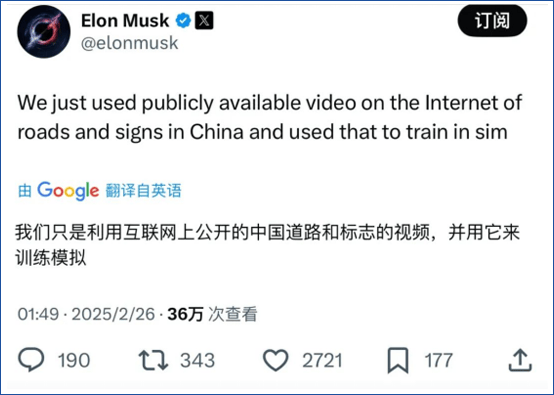
Figure: Musk revealed that the domestic FSD is not trained locally.
In terms of marketing and brand reputation, Tesla has experienced a series of public opinion controversies such as "brake issues," "out-of-control incidents," and "roof rights protection." Although it has ostensibly won lawsuits related to these issues, the problems exposed in its product quality and after-sales links have attracted the high attention of market regulatory authorities and led to multiple interviews. The impact of these incidents on consumers' purchase decisions remains to be seen.
Upon entering the Chinese market, Tesla showcased a diverse brand image. Musk personally visited the Shanghai Gigafactory, handed over cars in person, and danced impromptu, conveying a charming and approachable aura. The demonstration of autonomous driving technology and the application of gull-wing door design highlighted its technological and futuristic feel. The online ordering and in-store pickup model brought a new experience to consumers.
However, times have changed. A decade later, the Chinese new energy vehicle market has undergone tremendous changes. The competitors Tesla faces in China are no longer what they used to be. From their initial nascent stages to today's flourishing and diverse landscape, these competitors have grown rapidly. Tesla's role and position in the market are undergoing subtle changes.
The Rise of Domestic New Forces and Tesla's Sales Under Pressure
In the increasingly competitive global new energy vehicle market, Tesla's sales have declined, while domestic new forces have risen to prominence and performed impressively, opening up a new landscape in the new energy vehicle market.
Data from the China Passenger Car Association shows that in February, the domestic new energy vehicle retail market witnessed explosive growth, with sales surging by 79.7% year-on-year. Major domestic new energy vehicle makers have achieved remarkable results: BYD sold 185,400 units, a surge of 88% year-on-year, with a market share of up to 28.25%, firmly occupying the top position in the industry; Geely Auto's sales climbed to 57,000 units, an increase of 97% year-on-year, showing strong growth momentum; SAIC-GM-Wuling sold 49,200 units, with a year-on-year increase of 98%, continuing to occupy an important position in the market; Xpeng Motors saw a leap in sales, reaching 25,500 units, a year-on-year surge of 443%; Xiaomi Auto made its debut in the sales ranking top 10 with sales of 23,800 units, successfully gaining a foothold in the new energy vehicle market. In addition, domestic new energy brands such as GAC AION, Leapmotor, and Changan Automobile all showed general growth in sales, continuously gaining market share in competition.
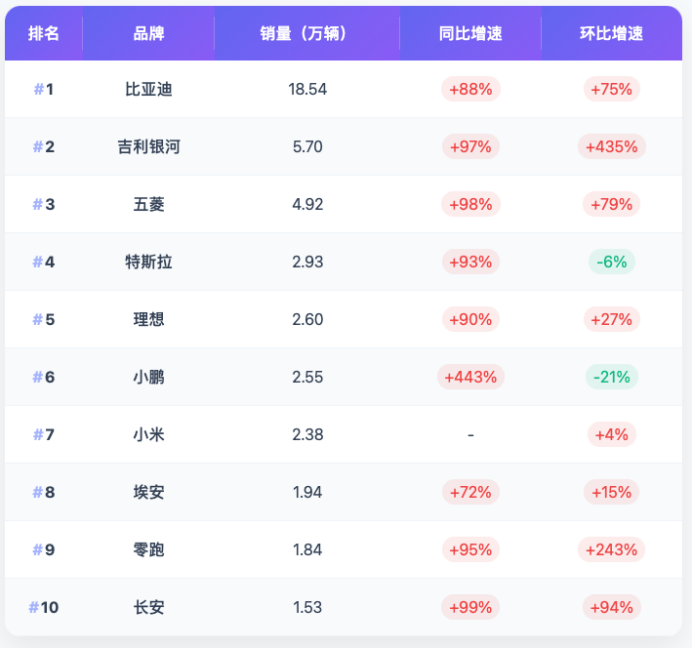
Sales ranking of new energy brands in February 2025.
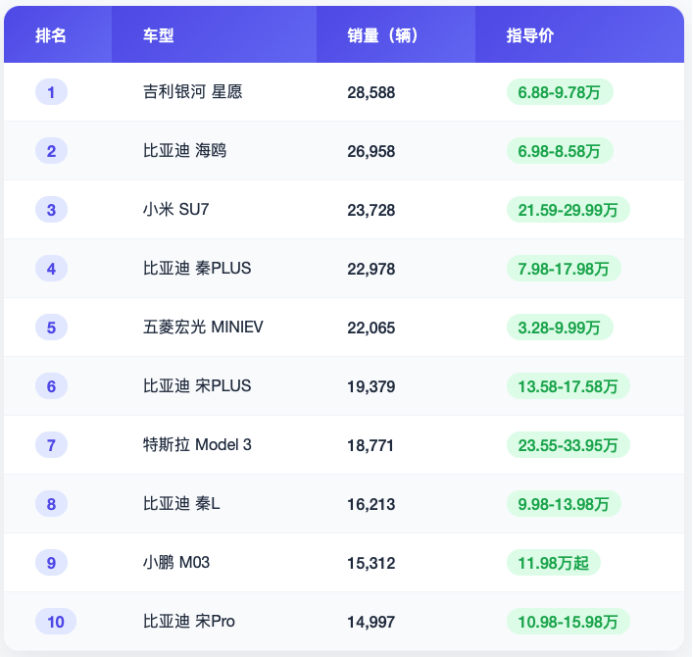
Figure: Sales ranking of new energy vehicles in February 2025.
In February, the domestic new energy vehicle market was booming, with sales of many brands rising steadily, making Tesla's sales decline particularly prominent. Recalling seven or eight years ago, when the Model 3 and Model Y first entered the Chinese market, consumers had very limited choices in the field of new energy vehicles. Nowadays, new energy brands are springing up like mushrooms after rain, and market choices have exploded. What is puzzling is that in an environment where many new energy brands are generally rising, Tesla, as a "veteran," has struggled to maintain its lead in the new energy sector it pioneered. What are the reasons behind this?
When Tesla was first established, its main competitors were traditional automakers. However, with the rise of Chinese new energy vehicle makers with an Internet spirit, Tesla has instead been labeled a "traditional automaker" by the market, playing out a commercial scenario of "an unorthodox fighter defeating a master."
The core of the Internet spirit lies in popularization, rapid iteration, and some services being free. Chinese new energy vehicle makers have precisely grasped this essence and are unrivaled in catering to the needs of local consumers. From entry-level commuter cars costing less than 100,000 yuan to hardcore off-road vehicles costing over one million yuan, domestic automakers' product lines are extremely comprehensive, meeting the diverse needs of different consumer groups. The February new car sales ranking shows that among the top five models, except for Xiaomi SU7, the rest are A0-class models with prices below 100,000 yuan. This type of economical and practical model is deeply favored by Chinese consumers.
In the 200,000-300,000 yuan price range, which is mainly covered by domestic Tesla models, it can be described as a "must-fight battlefield" for new forces with an Internet spirit such as Xiaomi, Xpeng, and Zeekr, where competition is particularly fierce. These new force automakers rely on their keen market insight and rapid response mechanism to continuously introduce new products. In contrast, Tesla's two main models have lagged behind in shaping product competitiveness and the speed of updates and iterations, making it difficult for them to compete with numerous rivals and gradually losing their advantage in this fierce market game.
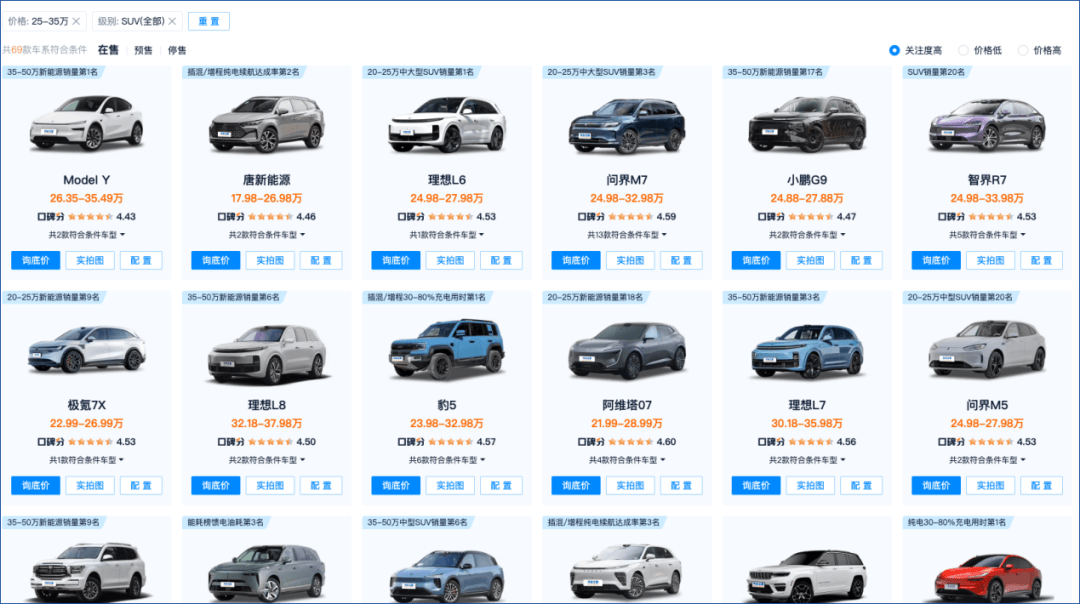
Figure: There are as many as 69 new energy vehicle models priced between 200,000 and 250,000 yuan.
In the luxury car segment, the price range of 400,000-600,000 yuan has always been fiercely competitive. NIO, AITO, and Li Auto have gained a firm foothold and dominated this niche market after years of cultivation through precise market positioning and continuous technological investment. Tesla's Model X, once a benchmark in the high-end SUV segment, has lost its competitiveness due to its long-term reliance on imports, not only in terms of pricing but also because of the pressure from tariffs and transportation costs. When facing domestic high-end competitors, its advantages are no longer evident, and its share in the high-end SUV market is gradually being eroded.
Compared to Tesla, a significant advantage of new force automakers lies in the speed of product iteration. They skillfully apply the rapid iteration model from the consumer electronics field to automobile manufacturing. Taking Xiaomi Auto as an example, since the launch of three versions of the Xiaomi SU7 in March last year, it quickly introduced the SU7 Ultra less than a year later, further enriching its product line and meeting the diversified needs of consumers. Xpeng Motors has also been active, launching new models or upgrading existing models almost every quarter in the past two years. On March 17 this year, the upgraded models of the Xpeng G6 and G9 were officially released, with a primary assembly renewal rate of up to 34%, almost like launching entirely new products. It is worth mentioning that it has only been a little over a year since their initial launch, which fully demonstrates Xpeng Motors' rapid response to market demand.
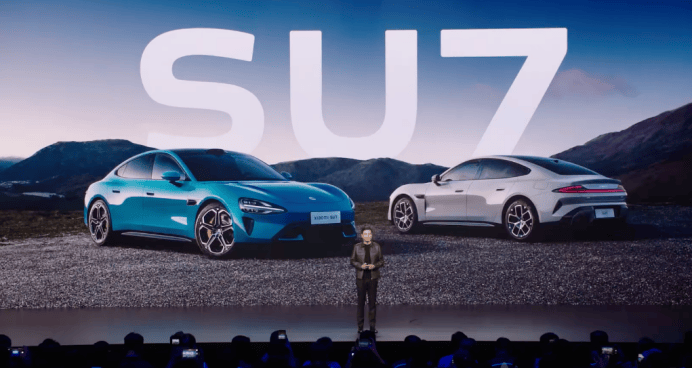
Figure: Xiaomi SU7 can be considered the most direct competitor of Tesla Model 3.
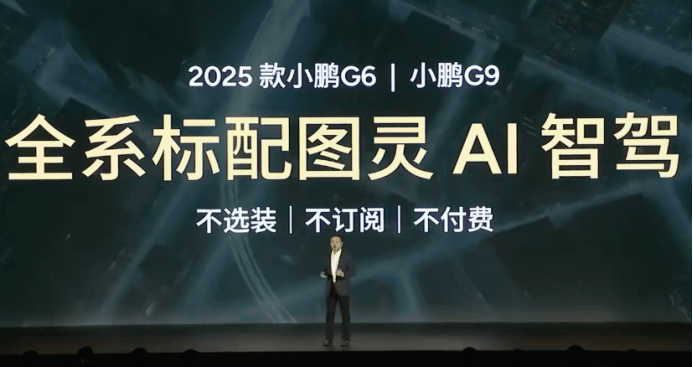
Figure: He Xiaopeng announces that intelligent driving will be included "free" with all car models
BYD, with its sales soaring ahead of the competition, has significantly accelerated its product iteration pace. Its flagship models, the Han L and Tang L, completed their generational upgrades in just two years after their launch, achieving a significant technical breakthrough. Furthermore, BYD plans to introduce at least four new pure electric models, including the Qin L EV and Seal 05, within the year, continuously enriching its product portfolio to cater to the diverse needs of the market.
Conversely, Tesla's flagship models, the Model 3 and Model Y, have seen mostly incremental upgrades since their inception, akin to squeezing a tube of toothpaste, in stark contrast to the innovation efforts of domestic automakers. Tesla's iterative approach, which mirrors that of traditional automakers like BBA, involves major overhauls only 8-10 years after the launch of a new model. This pace is clearly out of step with the rapid product update demands of consumers in the internet era.
Tesla's $64,000 fee for its Full Self-Driving (FSD) capability has garnered widespread criticism from owners, further scrutinizing the company. In comparison, domestic new-energy automakers offer more flexible and affordable pricing models for intelligent driving services. These automakers provide multiple options such as subscription-based pricing and buyout options, and some models even offer intelligent driving features at no additional cost. Even when a fee is required, consumers do not have to bear excessively high costs, unlike Tesla, which asks owners to spend a quarter of the price of a new car to unlock intelligent driving features (Model 3 starting price of 235,500 yuan).
Tesla appears to have underestimated the rapid pace of change in today's era.
Back in April 2014, Tesla CEO Elon Musk first set foot on Chinese soil, personally delivering the Model S to the inaugural batch of owners. Perhaps Musk did not foresee at the time that this list would include industry pioneers like Li Xiang and Li Bin, and later, Lei Jun also purchased a Model S from his own pocket.
It is unclear what valuable insights these leaders of new-energy automakers gleaned from the Model S. However, it is ironic that Tesla, once prided as the "benchmark for new-energy technology and intelligent driving," may now find itself seeking counsel from those very "first owners" of years past.
Since the first delivery of the Model S in 2014, Tesla's sales in China have skyrocketed, achieving remarkable growth over the past decade. In 2024, China's new-energy vehicle sales surpassed the 10 million mark for the first time. While Tesla was a witness to this milestone, it has gradually lost its former edge in the fiercely competitive market.
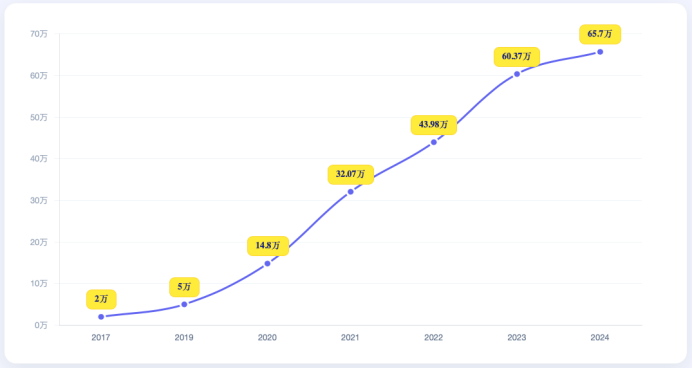
Figure: Tesla's annual sales in China
Once upon a time, Tesla, with its Silicon Valley innovation aura, forcefully disrupted the staid atmosphere of the traditional automotive industry and swiftly became synonymous with tech elites through its tech-forward products. Its models were in high demand upon launch, with orders piling up and even becoming a "status symbol" with significant social cachet. However, as time passes and the market landscape transforms dramatically, domestic new-energy automakers such as NIO, XPeng, and Li Auto have successfully seized the "traffic password".
Today, alongside Tesla stores in shopping malls, various domestic new-energy exhibition halls have sprung up like mushrooms after rain. The autonomous driving technology that once made Tesla proud and unmatched has now been innovated by domestic manufacturers to new heights. The topic of heated discussion is no longer the astonishing 2.8-second zero-to-hundred acceleration of the Model S, but rather the extreme speed of 300 km/h achieved by Xiaomi's SU7 Ultra. It's not that Tesla is unwilling to keep pace; it's simply that the world is evolving at a breakneck speed.
In reality, Tesla is far from declining. Judging from its 2025 strategic plan, the Model Q is imminent, the Model Y will be upgraded, and the Cybertruck is also planned for localization, diversifying and enhancing its product matrix. In the realm of intelligent assisted driving, Tesla has embarked on deep cooperation with Baidu to prepare for the implementation of technology in the Chinese market. The production capacity of the Shanghai Gigafactory continues to climb, further solidifying its production advantages. Additionally, Zhu Xiaotong, who was promoted to one of Tesla's four global senior executives two years ago, has successfully replicated the "China speed" at the Texas factory, fostering the coordinated development of global operations. These initiatives underscore Tesla's robust foundation in the Chinese market.
However, it must be unequivocally recognized that the competition in China's new-energy vehicle market is more intense than in any other single market. In this market brimming with opportunities and challenges, Tesla, if it becomes complacent and slows its pace, risks being outpaced by the market. Here, there is no perpetual leader; only those who embrace challenges and forge ahead courageously can secure a foothold in this fierce competition.







